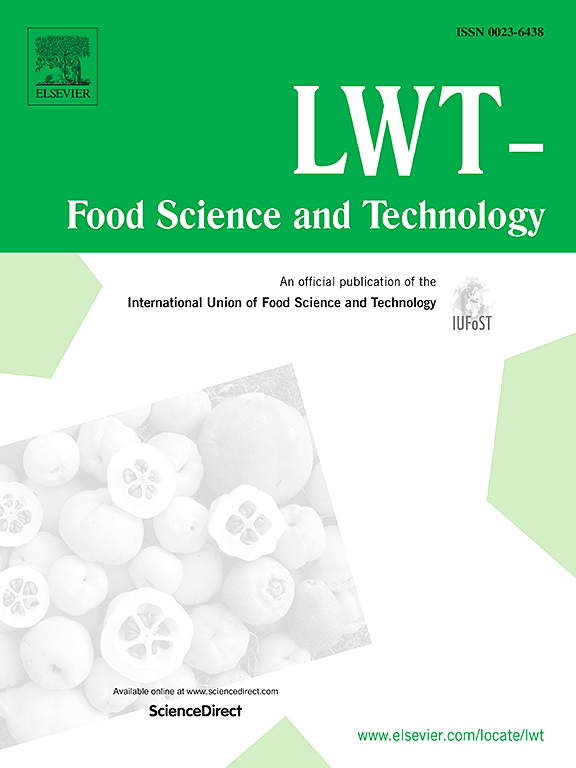SARS-CoV-2谱系B.1和EG.5.1在植物性食品中的持久性和活力:对食品安全和传播的影响
IF 6.6
1区 农林科学
Q1 FOOD SCIENCE & TECHNOLOGY
引用次数: 0
摘要
严重急性呼吸综合征冠状病毒-2 (SARS-CoV-2)出现5年后,仍在讨论通过污染物传播的途径。因此,在目前的研究中,十种植物性食物(苹果,葡萄,茴香,胡萝卜,生菜,芹菜,番茄,萝卜,火箭和黄瓜)。采用喷施50 μL病毒液对基质进行人工污染,通过RT-qPCR、接种Vero E6细胞和TCID50检测RNA持久性和病毒活力,并在污染后0.5 ~ 96 h的7个时间点进行分析。EG.5.1变异表现出较长的环境稳定性,除芹菜(24小时)外,污染后96小时在所有基质上都能检测到病毒RNA,而B.1基因的RNA持久性较差,特别是在胡萝卜和火箭上(分别为24 - 48小时)。相反,B.1在大多数基质上存活4小时,而EG.5.1在葡萄、茴香、生菜和芹菜上存活30分钟。这些结果表明,虽然清洗和热加工等食品制备方法有效地降低了病毒存在的风险,但加工后的污染可能促进污染物介导的传播,特别是通过原料产品传播。这些发现有助于对SARS-CoV-2传播途径的持续评估,并强调了在整个食品供应链中采取严格卫生措施的重要性。本文章由计算机程序翻译,如有差异,请以英文原文为准。

Persistence and viability of SARS-CoV-2 lineages B.1 and EG.5.1 on plant-based foods: Implications for food safety and transmission
Five years post-emergence of Severe Acute Respiratory Syndrome Coronavirus-2 (SARS-CoV-2) the route of transmission through fomites is still discussed. Therefore, in the present study ten plant-based foods (apple, grape, fennel, carrot, lettuce, celery, tomato, radish, rocket, and cucumber). The matrices were artificially contaminated by spraying 50 μL of viral solution, and RNA persistence and viral viability were assessed via RT-qPCR, Vero E6 cell inoculum, and TCID50 assays, and analysed at seven time points (0.5–96 h post-contamination). The EG.5.1 variant demonstrated longer environmental stability, with viral RNA detectable on all matrices up to 96 h post-contamination except for celery (24 h), while lineage B.1 RNA was less persistent, particularly on carrot and rocket (24–48 h, respectively). Conversely, B.1 remained viable up to 4 h on most matrices, while EG.5.1 viability ceased by 30 min on grape, fennel, lettuce, and celery.
These results suggest that while food preparation practices such as washing and thermal processing effectively reduce the risk of viral presence, post-processing contamination may facilitate fomite-mediated transmission, particularly via raw products. These findings contribute to the ongoing evaluation of SARS-CoV-2 transmission routes and highlight the importance of stringent hygiene practices throughout the food supply chain.
求助全文
通过发布文献求助,成功后即可免费获取论文全文。
去求助
来源期刊

LWT - Food Science and Technology
工程技术-食品科技
CiteScore
11.80
自引率
6.70%
发文量
1724
审稿时长
65 days
期刊介绍:
LWT - Food Science and Technology is an international journal that publishes innovative papers in the fields of food chemistry, biochemistry, microbiology, technology and nutrition. The work described should be innovative either in the approach or in the methods used. The significance of the results either for the science community or for the food industry must also be specified. Contributions written in English are welcomed in the form of review articles, short reviews, research papers, and research notes. Papers featuring animal trials and cell cultures are outside the scope of the journal and will not be considered for publication.
 求助内容:
求助内容: 应助结果提醒方式:
应助结果提醒方式:


